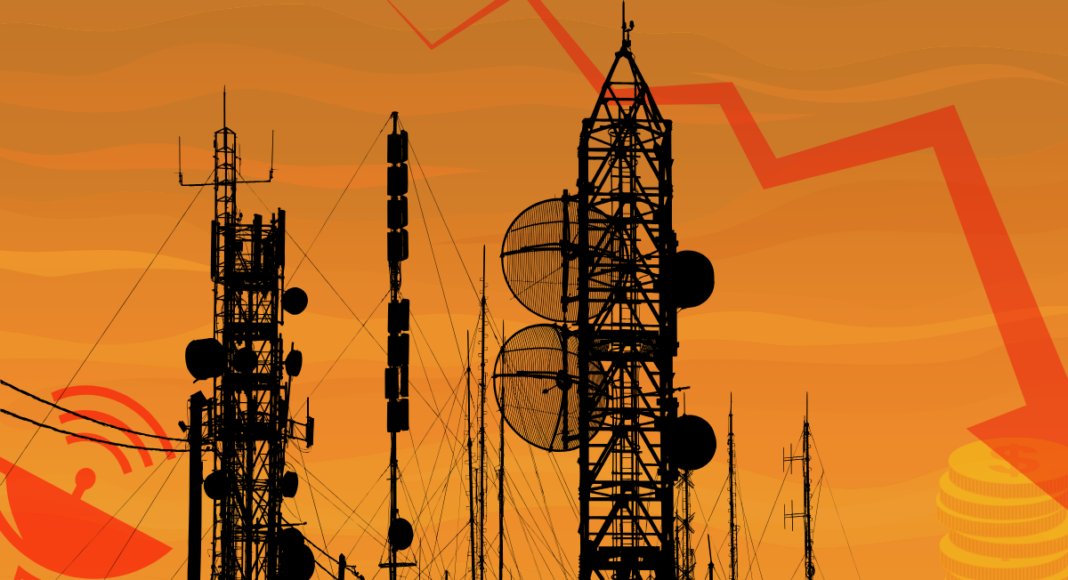In recent weeks, a spate of mergers has been announced in telecommunications markets. The activity endangers Americans’ access to affordable and reliable internet services. Rather than continue to depend on private companies to provide essential internet services, cities should look to the many communities that have provided significantly lower-cost and higher-quality public internet connectivity, writes Sean Gonsalves.
On the evening of March 7, 1916, Theodore Vail—the legendary first president of AT&T—swaggered into the New Willard Hotel in Washington, D.C., to be honored at a banquet celebrating the achievements of his beloved Bell system. The Bell system and sublicenses, owned by AT&T, had approached a 90 percent market share at this time as Vail championed and aggressively pursued a telecom monopoly. The echoes of this evening ring loud today.
Vail fancied himself the Theodore Roosevelt of private industry, projecting a larger-than-life persona. “Mr Vail is a big man,” Thomas Edison said of him, though he wasn’t merely describing the burly boss’ physical stature. Edison was talking about the vastness of Vail’s corporate vision, which 100 years later would rightfully earn him the moniker as “the greatest monopolist in the history of the information industries,” as Tim Wu wrote in his acclaimed book “The Master Switch: The Rise and Fall of Information Empires.”
Rejecting Adam Smith’s vision of capitalism, Vail openly espoused his disdain for “competition” and his affection for centralized monopolies, on both “efficiency” and “moral” grounds. At the birth of Ma Bell (the original parent company which was eventually broken up into the “Baby Bells”), the telecommunication titan explicitly called for “a universal wire system for the electrical transmission of intelligence…as extensive as the highway system of the country, which extends from every man’s door to every other man’s door”—all of which would be controlled by AT&T.
Of course, AT&T’s monopoly was eventually broken up in 1982. Now, nearly 50 years later—in what feels like our new Gilded Age—it probably shouldn’t surprise us that the spirit of Vail has returned with a vengeance.
Last month, AT&T announced it would acquire all of Lumen Technologies’ fiber internet business for $5.75 billion. According to a company statement, the purchase will net AT&T one million fiber customers and significantly expand its fiber footprint in Denver, Las Vegas, Minneapolis-St. Paul, Orlando, Phoenix, Portland, Salt Lake City, and Seattle.
Across AT&T and Lumen’s service areas, where they offer wired or licensed fixed wireless Internet service, more than half of the locations they claim to serve have two or fewer options for high-speed internet service.
Good news for AT&T stockholders. Not so good news for broadband-hungry subscribers who, for years now, have been paying among the highest prices for internet service of any developed nation in the world. Ever wonder why that is? The answer is as painfully obvious as our overpriced monthly internet bills.
When big telecom giants consolidate—especially in a market where most people have only one or maybe two internet service providers (ISPs) to choose from—the results are predictable: without meaningful competition for something as fundamental as internet connectivity in an internet-connected world, monopolists have no incentive to improve service, invest in network upgrades, or compete on price.
If you are one of the 80 million or so Americans who live in an area with only one ISP, the monopoly provider has you over a barrel where your choice is: pay us whatever we charge, no matter how unreliable the service may be, or good luck participating in the digital economy without us. Such is the case in LA County, where a 2022 report from the California Community Foundation found that Charter Spectrum was the only ISP for the majority of addresses in the study, and that price disparities existed with high-poverty neighborhoods charged more for slower internet speeds, while wealthier neighborhoods received better pricing for high-speed internet.
Sometimes, the only options available are overpriced internet or no internet at all. In other situations, even that choice is unavailable. Ask the residents of Detroit’s Hope Village neighborhood, who experienced a six-week AT&T internet outage during the COVID lockdowns, when the need for internet access was inescapable.
Despite the documented harms of inadequate competition begetting inadequate internet service, telecom monopolists are marching ahead with little resistance. Just a week before news of AT&T’s looming acquisition of Lumen, which hasn’t yet received regulatory approval, Verizon completed its $20 billion acquisition of Frontier Communications—a merger approved by the FCC after Verizon agreed to rollback its diversity, equity, and inclusion (DEI) initiatives at the insistence of the Trump administration and its war on “woke.”
The consolidation-palooza doesn’t end with AT&T and Verizon. Charter Communications also announced in May a $34.5 billion agreement to acquire Cox Communications, which will make it the single biggest cable company in the nation, bypassing Comcast. CNBC called it “one of the largest (mergers) in the industry—and across corporate America—in the last year.”
The justification for these mergers is that they don’t technically reduce choice among broadband subscribers since the merging companies rarely compete in the same geographical markets. However, they do preclude the possibility for these companies to eventually compete with one another.
AT&T, Verizon, and Charter all have the market capitalization and resources to expand their existing infrastructure into new markets. AT&T, for example, plans to give $40 billion to investors over the next few years between dividend payments and stock buybacks. However, merging with an existing competitor means that there will be one fewer firm with which they have to compete in the future. The empowerment of regional monopoly providers will further erect higher barriers to entry to future potential competitors.
The data shows that these mergers are neither necessary for expansion nor beneficial to consumers. The illusion of efficiencies, however, will continue to persuade judges and regulators that they should be approved. But if efficiencies will continue to provide the trump card when adjudicating mergers, because efficiencies in theory produce lower costs and higher quality services for citizens, then we ought to pursue the market choices that empirically maximize efficiencies, and that is the public choice.
Communities served by electric cooperatives, open access networks on which multiple small independent ISPs compete, and cities with their own municipal broadband service are all delivering fiber internet access—the gold standard of internet connectivity—to every household and business in their service areas at affordable rates, with no data caps or hidden fees.
Fairlawn, Ohio, has FairlawnGig, a city-owned municipal broadband service. Two years ago, at a time when pundits, politicians, and large swaths of the public were focused on inflation, FairlawnGig subscribers saw their basic service speeds voluntarily spiked (not throttled) while their monthly bills were slashed. You can get a symmetrical gigabit connection for just $55 a month in Fairlawn. That’s about half as much as most of us pay for inferior cable connectivity.
In Longmont, Colorado, the city built, owns, and operates NextLight Fiber as a city utility. Longmont residents and businesses, just like their Front Range neighbors in Loveland, Fort Collins, and Estes Park, all have reliable gig-speed fiber service, an indisputably superior technology, for less than what the big corporate ISPs offer. They also outperform the big ISPs year after year in PCMag’s annual ranking of the nation’s fastest ISPs as well as consumer satisfaction rankings.
There are literally hundreds of examples like this all across the country. And they’re not confined to cities. More than 200 electric cooperatives serving rural communities from Florida to Oregon are bringing broadband to areas the big guys have for decades spurned because building networks in sparsely populated rural markets is simply not profitable enough for them. Making matters even worse, the Trump Administration is on the brink of completely upending and undermining the Broadband Equity, Access, and Deployment (BEAD) program that Congress established with the bipartisan infrastructure law, which will be a significant blow to electric cooperatives who have been leading the charge in bringing broadband to rural communities across the nation.
To allow Big Cable and Telecom to further consolidate its monopoly grip on American households and small businesses will only ensure some Americans have access to high-priced, second-rate internet service, while the rest, living in mostly rural parts of the country, get access to nothing (or get in line for Starlink’s capacity-constrained and expensive service).
The “competition” that often looks more like collusion between the big monopoly providers is nothing Adam Smith would recognize as a free market and is a far cry from populism. Despite the radical technological transformations in the sector since the early days of AT&T, the monopoly mindset has been allowed to “preVail.” Only the dedicated enforcement of our antitrust laws and adherence to our antimonopoly foundations can end this retreat and return true choice and freedom to the telecommunications market.
Author Disclosure: The author works for the Institute for Local Self-Reliance, which receives funding from foundations such as the Wellspring Philanthropic Fund, Wallace Global Fund, Amalgamated Charitable Foundation, Methodist Healthcare Ministries, and Tides Foundation.
Articles represent the opinions of their writers, not necessarily those of the University of Chicago, the Booth School of Business, or its faculty.
Subscribe here for ProMarket‘s weekly newsletter, Special Interest, to stay up to date on ProMarket‘s coverage of the political economy and other content from the Stigler Center.






